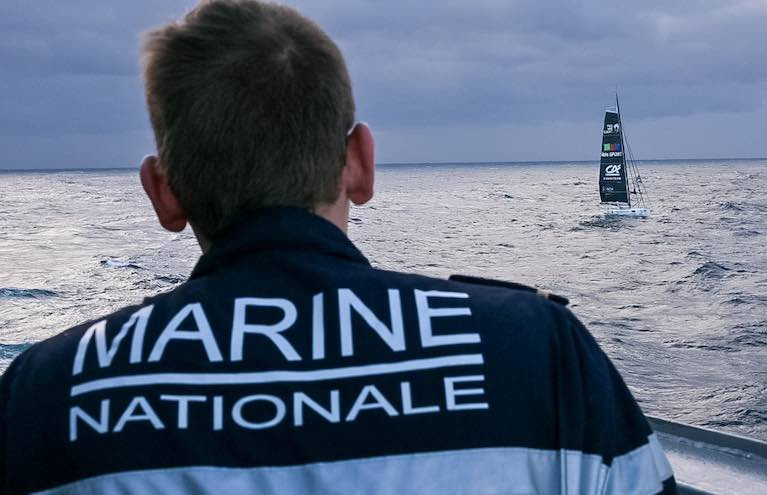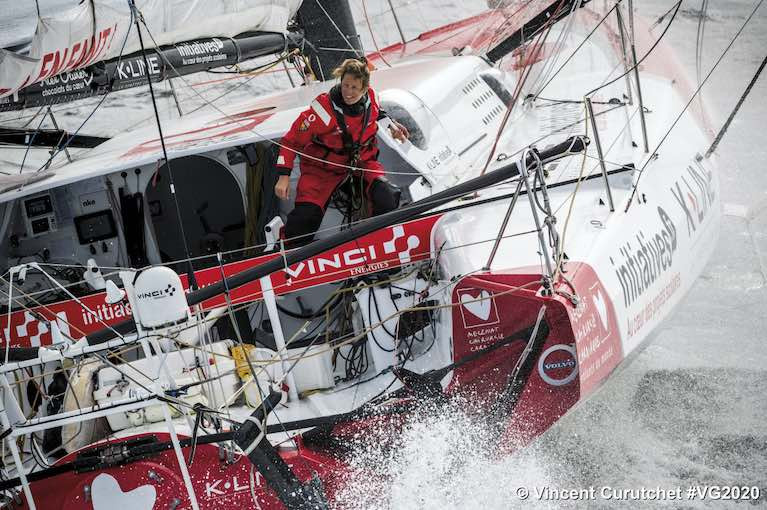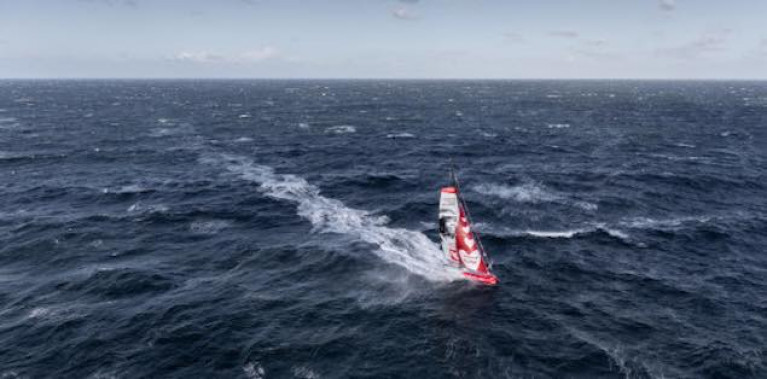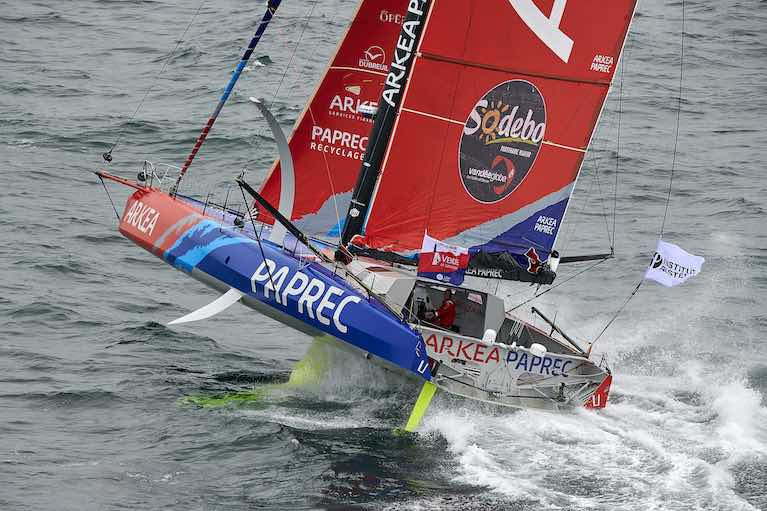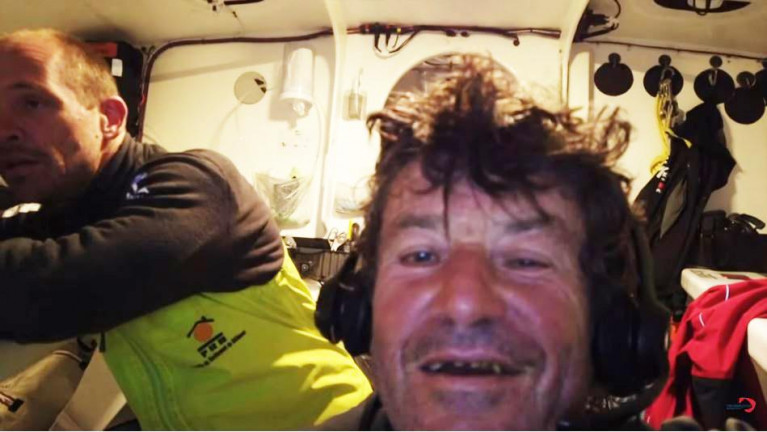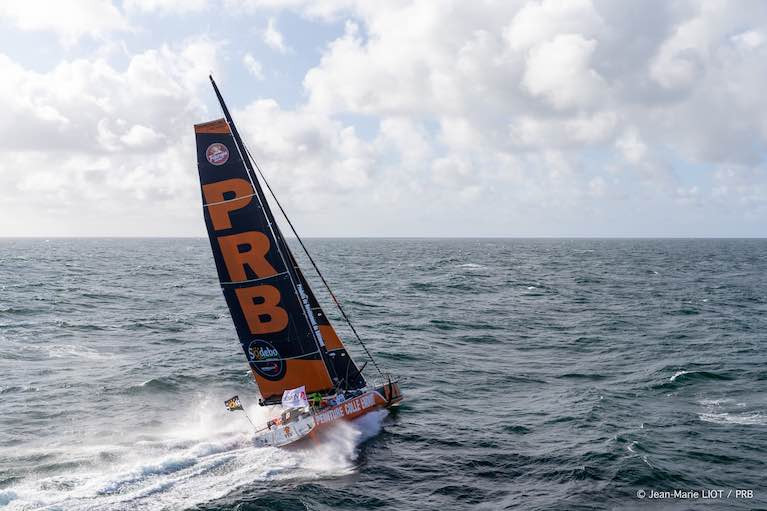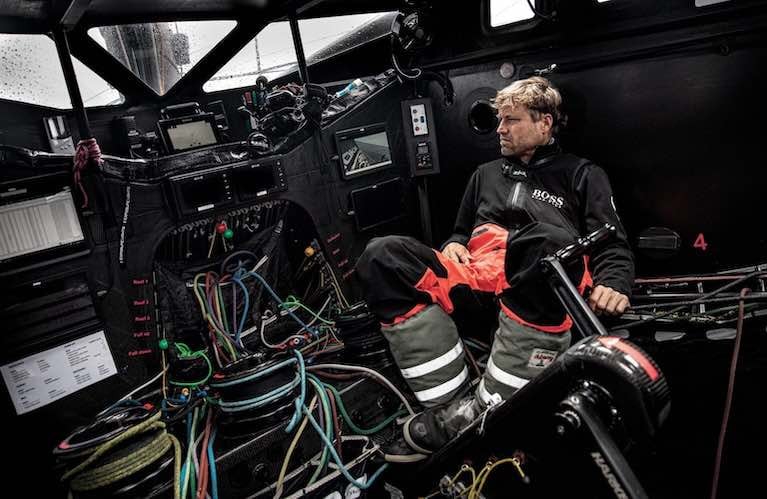Displaying items by tag: Vendee Globe
At around 0210hrs UTC at a location in the South Indian Ocean some 360 miles north of the remote Crozet archipelago, Kevin Escoffier (PRB) was successfully transferred from Jean Le Cam's IMOCA to the Nivôse, a French Navy frigate.
Escoffier was dramatically rescued last Monday by fellow Vendée Globe competitor Jean Le Cam after his IMOCA PRB broke in two when it nosedived into a big wave. The 35-year-old skipper from Saint-Malo had spent 11 and a half hours drifting in a liferaft before being picked up by 61-year-old five times Vendée Globe veteran Le Cam.
The evacuation of Escoffier - via a Nivôse rigid inflatable boat - went well, despite the big seas in the area.
 Kevin Escoffier (PRB) (right) was successfully transferred from Jean Le Cam's IMOCA to the Nivôse, a French Navy frigate
Kevin Escoffier (PRB) (right) was successfully transferred from Jean Le Cam's IMOCA to the Nivôse, a French Navy frigate
And so Jean Le Cam has resumed his race in solo mode. In a message to the Vendée Globe Race Direction, Frédéric Barbe the captain of the Nivôse, wrote: “Kevin is in great shape, he is going to enjoy a hot shower. We are heading for Reunion Island. It is the start of a beautiful day."
Nivôse is a Floréal-class frigate which has 84 sailors on board and its main missions are the surveillance of maritime areas under French sovereignty in the Indian Ocean (Reunion, Mayotte, the French Southern and Antarctic Territories) and the fight against illicit activities at sea. It is based in Port-des-Galets, on the west coast of Réunion island, Nivôse is 93.5 meters long, 14 meters wide and has a displacement of 2,600 tonnes.
Alex Thomson Arrives in Cape Town & Formally Retires From Vendee Globe
Each edition of the Vendée Globe, Cape Town, South Africa provides final safe haven for stricken solo racers to retire to, restore their mental equilibrium, to reflect on what should have been and to enjoy the safety and security of terra firma after nursing an injured IMOCA to port.
After nearly seven days and 1,800 miles since he announced his hopes of winning the 2020 Vendée Globe had been terminated by a broken starboard rudder, Alex Thomson arrived in Cape Town this morning. He will be joined over the weekend by the young Vendéen skipper, Sébastien Simon, who also announced he has had to give up the race because of damage to his starboard foil casing and his foil on the Juan K designed ARKEA PAPREC.
Of the 33 IMOCAs which started the race, four have now officially abandoned, CORUM L’Épargne, PRB, HUGO BOSS and ARKEA PAPREC.
Thomson said, “I’m still coming to terms with what’s happened, and I’m obviously utterly devastated that this is how the race has ended for us.”
“But, as I’ve said before, it’s in our toughest moments that we find our greatest strength. Now we have to pick ourselves up and move forwards, and I’ve no doubt that we can do that together as a team. Over the past week or so we’ve been reminded of just how difficult this race is. I’ve said it time and time again but there really is no sporting challenge in the world as tough as the Vendée Globe. I have such admiration for any skipper who takes on this race. My thoughts go out to those who, like us, have had their races cut short. And I wish the remaining skippers a safe passage and a good race. I’ll be watching closely.”
The British skipper has been forced into Cape Town in early December before. His first Vendée Globe ended with his retiral on 7th December 2004 after an area of his coachroof around the mast gave way due to a structural problem. And in 2006 he and Mike Golding arrived in Cape Town on December 3rd 2006 after Golding had dramatically rescued Thomson from his IMOCA in the Southern Ocean after he had to abandon it because his keel had failed. Golding’s mast broke not long after the rescue and the pair had to sail 1000 miles north under jury rig.
Britain’s Sam Davies is making steady progress north under reduced sail nursing her damaged Initiatives Coeur back to sheltered waters and this afternoon was about 80 miles south of Cape Town. After the best sleep since she hit a floating object which has damaged the structure round her keel, Davies admitted that the emotions were suddenly released as she was accompanied on her route by an albatross, “The sun came out too which helps to ease the aches and pains - I went and sat outside in the warm sun. And then suddenly found myself in floods of tears - and this is a bit weird for me, who never cries, to deal with all these emotions. I wasn’t even sure why I was crying - whether it was sadness for my boat and for my place in this race, or relief that my boat and I are safe? Or a mix of all these emotions? I’ve always felt that it’s stupid to cry when you are alone on your boat - nobody’s going to help you or hug you or reassure you so it’s pretty much a waste of time and energy. But at that particular moment I had no control over these emotions. I leant on the coach roof and looked out and there, right there, really close, unusually close, was the most beautiful albatross I have seen, gliding past silently and slowly. He was so close. Normally the albatrosses keep their distance but this was different, as if he could feel my emotion and wanted to help. He stayed close and gave me a wonderful display of effortless flight that was a welcome distraction. They say that albatrosses have the souls of sailors of the past and I can well believe that. I feel like I am being escorted to safety by these amazing creatures and I am grateful for their concern!”
Meantime, yesterday night, Romain Attanasio (Pure-Best Western), Davies’ partner was nervously crossing the exact same zone where she had her collision two days ago and where four years ago he hit something which damaged his rudder, requiring him to repair at anchor off Port Elizabeth.
“I am fully in the zone where Sam and Seb hit their OFNIs and it is exactly the same area as I did four years ago, the same spot same latitude, same longitude it is in the Agulhas current, there are all sorts of things in the water, objects, it is a zone which is a bit critical. I am reaching in quite a big sea and so I am on high alert. I have my eyes on OSCAR as much as possible, this camera system that surveys the route. You can’t see much in the water on the surface. So, it is not easy all this.” said Attanasio.
Conditions are still demanding for the fleet leaders who will shortly be able to angle more to the south east after passing the corner of the Antarctic Exclusion Zone. Led by Charlie Dalin (Apivia) with Louis Burton now just 140 miles behind on Bureau Vallée, they are still all struggling to set a good average speed in the typically big seas and gusty winds. A second, deeper low pressure is set to combine next week to provide very testing conditions which it is most likely the leaders will change their route to avoid.
The top ten now contains a fascinating mix of solo racers, six of them racing in the ‘big south’ for the first time, Charlie Dalin, Yannick Bestaven, Damien Seguin, Benjamin Dutreux. Isabelle Joschke and Giancarlo Pedote and still three non-foiling boats, those of Seguin, Dutreux and Jean Le Cam.
Louis Burton’s attacking force seems relentless, his wife Servane noting today on the Vendée Live English programme, “Louis never stops surprising me, but he has a mind of steel. When he went south he asked me, ‘will you still love me if I screw up?’
After both hitting floating objects within hours of each other yesterday at the gateway to the Indian Ocean and sustaining damage to their IMOCAs the emotion in the voices of both Sébastien Simon and Sam Davies was a stark reminder of the cruel fates which are randomly dealt to even the best prepared and smartest Vendée Globe skippers.
Both are heading north towards South Africa out of the worst of the strong winds and big seas, sailing slowly north to shelter and assess their possibilities of repair. “I want to be able to continue my Vendée Globe”, said Simon, the 30-year-old from Les Sables d’Olonne who won La Solitaire du Figaro in 2018, close to tears. He has constant water ingress from around his foil box, while Davies damaged the longitudinal framing which supports the keel of Initiatives Coeur.
I hit something
She reported: “I was sailing at speeds between 15 and 22kts and I was actually just making a hot meal after the gybe and doing the stack and everything and it was just starting to get dark. I hit something. I did not see anything. I did not know what it was. It was pretty much dark when it happened. But it was as if I had run aground on a rock at the time. The boat speed went from 20kts to zero. The boat nosedived on the impact with the keel. I knew it was the keel. I heard a crack coming from there. I and everything else flew forwards, including my dinner which has repainted the entire inside of my boat. Everything moved. I went flying into a ring frame, luckily, because that could have been worse. It was really violent. But luckily, I have just hurt some ribs. It is not serious but really painful. But I stopped the boat, dropped the main, and went to check around the keel, the bearings and the bulkhead. The bulkhead, the main bearing bulkheads (which support the keel box) are intact as far as I can see. The keel bearings are intact. The longitudinal structure around the keel box is all cracked. That has taken the shock of the impact of when the boat moved, that is cracked on both sides.”
Vendée Globe Race Director a renowned former ocean racer Jacques Caraës empathised with the duo today. He explains: “Usually when you get to the gateway to the Indian Ocean, you go into another world, in another mode. You are reserved and back off. You have a more conservative attitude. Because the Deep South is a long tunnel, there is no other solution than to go to the end. And the exit is Cape Horn. There aren’t many safe havens. Psychologically, under these circumstances, it's hard."
Louis Burton in Second
Given the tenacity of his attack since arriving in the Roaring Forties, prepared to push his boat hard and work closer to the centre of the Southern Ocean low pressure systems, it is in retrospect maybe that Louis Burton jumping the Vendée Globe start gun back on Sunday November 8th shows a foretaste of what the 35-year-old from Saint Malo’s mindset is on this race.
Indeed, right now Burton, who is competing on his third Vendée Globe, might seem to have more in common with Alex Thomson than just Welsh roots. (Thomson was born in Cardiff, Burton’s father is Welsh and was formerly newspaper editor). Married to Servane Escoffier whose cousin is PRB’s Kevin Escoffier, Louis Burton is on his third Vendée Globe. He had to retire early in the 2012 race when he hit a fishing boat off the Portuguese coast and sustained damage to the rig of his IMOCA. He returned in 2016-17 and finished a solid sixth, sailing much of his race in relative isolation, but always sailing smart, smooth courses and looking after his boat.
And, like Thomson, Burton eschews training groups, the French ‘Pôles’, and so prefers to prepare in isolation with his tight-knit group of technical experts from his base in Saint Malo.
Near miss
Remarkably Parisian bred Burton, who went to the Breton Glenans sailing institution as a 15-year-old already served out seven hours of penalties early in this race, five hours sin-binned for jumping the start gun and a further two for a prop sealing incident, where his team did not send the required photo as directed. He also reported a near miss with another unmarked, fishing boat which had no AIS.
Looking relaxed and wearing a big smile Burton reported from his Bureau Vallée 2 that “conditions are a bit complicated and not very stable. There are periods of calm allowing me to get more sail back up and the speed up. I have to do a lot of gybes in heavy seas. I did one during the night with 45 knots of wind, so have to be very careful. The sea is nasty but apart from the sea state it’s not too bad. It’s nice to be in this position in the Indian Ocean. The advantage is that it allows me to manage things and watch what is going on with the other boats behind me.”
Davies and Simon are the latest victims of floating objects in the water. So, what might be the reasons for these multiple collisions with objects? Alex Thomson said in his final message that he thought it was discarded or lost fishing gear that knocked out his rudder. Ice is very unlikely as there is normally no ice drifting north of the AEZ (Antarctic Exclusion Zone) and Race Direction has recently confirmed again by email the positions of ice and it is all very much in the south.
But in the area south of the Cape of Good Hope the mixing sea currents stir up billions of tons of seawater, warm coming south from the Indian Ocean sliding along the coast of Mozambique and cold waters coming up from the Antarctic meaning a proliferation of sea mammals feeding. And it is very busy area for commercial shipping traffic. The seas are often very big, confused and chaotic due to the Agulhas current which throws up occasional rogue waves that can carry many containers and other material into the sea.
Le Cam Rendezvous with French Frigate
Caraës explained today of the plan for Yes We Cam! to rendezvous with the French frigate Nivôse is a Floréal-class frigate which is on duty in the Southern Ocean. The plan is very much weather dependent as well as contingent on Jean Le Cam’s decision on any required detour.
Icebergs Detected on the Vendee Globe Skippers Route
Since 2008, CLS, Official Supplier of ice data for the Vendée Globe, has been using technologies and satellites designed and deployed by CNES (French National Center for Space Studies) and ESA (European Space Agency) to detect icebergs threatening the skippers' route.
This year, a dozen satellites, including Sentinels 1 and 3, and no less than 300 radar images will be used to detect these UFOs (Unidentified Floating Objects) that haunt any sailor sailing in the southern seas.
CLS radar imagery analysts have detected around 20 questionable icebergs in about 50 images in the Crozet and Kerguelen area of the French Southern and Antarctic Lands (TAAF). Faced with these doubts, the Vendée Globe race management, after consulting with CLS teams, did not hesitate to raise the Antarctic Exclusion Zone by 5 degrees further north, lengthening this safety cordon by more than 400km.
The Antarctic Exclusion Zone is a virtual zone where the skippers are forbidden to sail under risk of encountering these icy monsters, a crossing that could endanger their safety but also cost them penalties.
British Vendee Globe skipper Sam Davies informed her team that her IMOCA Initiatives-Coeur had struck a floating object at around 1900hrs UTC yesterday evening.
She is heading north this morning at reduced speed and will inspect her boat to assess the damage and discuss actions with her team.
Sam Davies is unhurt, according to official reports.
Nine IMOCAs Pass Cape of Good Hope in Same Day of Vendee Globe Race
Given that the Vendée Globe fleet started on Sunday 8th November in Les Sables d’Olonne with a record-sized fleet of 33 IMOCAs and there are still, technically, 31 tracked on the race course, it is not entirely unexpected to have no fewer than nine boats (and ten skippers) cross the longitude of the Cape of Good Hope today. But this is a unique, unprecedented statistic for a unique and ever more engaging edition of the solo non-stop round the world race.
Passing at 0230hrs UTC this Wednesday morning in fourth place was Sébastien Simon on ARKEA PAPREC. The 30-year-old Les Sablais skipper has been showing good speeds in recent days on the 2020 Juan K design. But no sooner was he into the Indian Ocean than he reported substantial damage to his starboard foil and its casing after hitting an object in the water at 0820hrs UTC this morning.
Water ingress
Simon slowed the boat which had some unspecified amount of water ingress, and had stabilised the situation, this afternoon making between eight and 12kts on port gybe racing towards the back of a low pressure system.
After ARKEA PAPREC crossed Good Hope the IMOCAs passed Good Hope like buses, Germany’s Boris Herrmann (Seaexplorer-Yacht Club de Monaco) at 1hr 4min after Simon, Jean Le Cam (Yes We Cam!) crossed 1hr 17 min after the German skipper, then Damien Seguin (Groupe Apicil) 42mins later, Yannick Bestaven (Maitre Coq IV) 3hrs 09mins after, Benjamin Dutreux (OMIA-Water Family) 1hr 50 mins later, Giancarlo Pedote (Prysmian Group) 2hrs 12 mins later, then came Sam Davies (Initiatives Coeur) 1hr 50m later. Isabelle Joschke (MACSF) crossed 1hr 4mins after Davies.
Confidence to attack
The proven reliability of the 2016-17 race winning boat, now Bureau Vallée 2, and the desire and confidence to attack hard seem to be the key to Louis Burton’s progress up the leaderboard. So far he has routed south, closer to the ice exclusion zone and so sailing less miles but always in stronger winds and bigger seas. The 35-year-old from Saint-Malo was seventh on the last edition of the race, blessed with a passage through the southern oceans mostly in relatively benevolent conditions thanks to a high-pressure system which he rode for weeks.
President of France
Rescued Kevin Escoffier and rescuer Jean Le Cam were called by Skype onboard Yes We Cam! by the President of France, Emmanuel Macron who congratulated Le Cam on his seamanship, saying,
“I was reassured by the news. I am a fan of Jean’s. So I wanted to say hats off to him. We are extremely proud of Kevin and you and for the whole ‘family’ and of what you did.” Said Macron
It is still planned to drop Kevin Escoffier on a French navy frigate the Nivose which could rendezvous with Yes We Cam near the Crozet or Kerguelens but this has not yet been confirmed by the authorities. If not it might be New Zealand before Escoffier could be taken off.
For all that the latest generation of high speed foiling IMOCAs are designed for top speeds of more than 30kts, now racing in the steep, short seas of the Indian Ocean, race leader Charlie Dalin has been through his biggest storm to date and today said he is having to learn how to slow his boat and manage it.
“ I am discovering something I have never had to do before.” said Dalin, “ I have to un-trim, detune my boat. I feel now 50% of the time I am trying to trim the sails and the foils and keel to go faster, and 50% of the time I am de-tuning the boat. I find myself looking for the brake pedal. The sea state in the Indian Ocean is really what is limiting my speed. Sometimes the boat accelerates in the surf and we go to 28-30kts and you don’t know how it is going to end. It is a really weird to way to think, ‘I have this wind strength, this wind angle is this and I have these sails up, and I have the foil set like this, but if I change all these settings I should slow the boat down, and slow the boat down.' I never had to do this before in my racing career.”
Lead of over 250 miles
With a lead of over 250 miles, Dalin admitted today he no longer routes his rivals, Burton tracking 165 nautical miles south of third-placed Ruyant, not because he doesn’t care but he considers it wasted energy when they are in different wind regimes, “ I have stopped routing them. Entirely. I have voluntarily stopped taking the GRIB files back to Thomas. I cannot do that. I don’t want to know what conditions he is going to have. There is not much point. We have different weather systems, we are a bit more than 12 hours apart, so there is not much point. I focus on my race, my course. And we will see how it turns out. I have given up. I don’t find it useful to do this.”
Relieved Escoffier Speaks About His Vendee Globe Rescue By Jean Le Cam
After being rescued from his liferaft by fellow Vendée Globe competitor Jean Le Cam in big seas and strong winds the early hours of this morning some 840 nautical miles South West of Cape Town, South Africa, Kevin Escoffier has been recovering on board Le Cam’s appropriately named IMOCA 60 Yes We Cam!
The 40-year-old solo sailor, a member of a well known Saint Malo sailing family, had to abandon his IMOCA 60 PRB, within what he later estimated to be two minutes when his boat virtually broke in two after burying its nose in a wave while racing in five metre waves and 25 knot South Westerly winds. Escoffier only had time to grab his survival suit before being washed off the boat and clambering into his liferaft which automatically inflated.
Veteran 61-year-old Jean Le Cam, racing on his fifth Vendée Globe, answered the request of Race Direction to divert to try and pick up Escoffier whose boat’s emergency beacon had been activated at 1346hrs UTC.
When he arrived in the area some two hours later he located Escoffier in his liferaft but was then unable to manoeuvre and prepare properly to effect a rescue on time before losing sight of the liferaft in the big seas, strong winds and growing darkness.
Race Direction in Les Sables d’Olonne diverted three other skippers, Germany’s Boris Herrmann (Seaexplorer-Yacht Club de Monaco), Yannick Bestaven (Maître CoQ IV) and Sébastien Simon (ARKEA PAPREC) and drew up a search protocol using Meteo France’s MOTHY ( (Modèle Océanique de Transport d'HYdrocarbures) drift prediction programme and engaged the three solo skippers in a triangle search pattern. They had intermittent distress beacon signals which appeared to follow no pattern.
But it was only when he was directed close to a locator beacon position which coordinated with the predicted drift pattern that Le Cam spotted a reflected beam of light bouncing off a wave that he realised he had finally located Escoffier again. He plucked him from the liferaft at 0118hrs UTC this morning.
It was only when the two suddenly appeared together on a Skype video call which had been running constantly from Le Cam’s boat to a monitor in the Les Sables d’Olonne HQ that Race Direction suddenly realised the mission had been successful and Escoffier had been rescued.
A world renowned ocean racer may have been on only his second ever solo IMOCA race but Escoffier has won the crewed Volvo Ocean Race in 2018 on the Dongfeng team and was part of a successful Trophée Jules Verne round the world in 2012. He was key technical director of Armel Le Cléac’h Vendée Globe winning programme on the 2016-17 race.
Smiling and relieved as he spoke to the Vendée Globe English Live from on board Le Cam’s Yes We Cam he said:
“I’m doing pretty well, pretty well, much better than last night. Which I spent in a very bad bed and breakfast (laughing). It’s still hard for me to believe it, to believe that I broke the boat inside the wave at 90 degrees. I should have taken a picture for people to believe me. Just after the wave, the bow was pointing at 90 degrees from the stern of the boat, and all the water was coming forward. The water level inside rose very fast and I had a very short time to decide what to do.
“After, well then I’ve been thinking about getting on the life-raft and if I should have waited. But it’s done, it’s done. Should I have been trying to stay a bit longer on the boat? It might have been better for people to find me but I’m pretty sure I wouldn’t have been able to stay the night on the boat. Because the water that was already above the deck level it was too dangerous. I was better in the life raft.”
“It’s unbelievable what happened. The boat folded up on a wave at 27 knots. I heard a bang, but to be honest, I didn’t need to hear that to know what had happened. I looked at the bow. It was at 90°. In a few seconds, there was water everywhere. The stern was under water and the bow was pointing up to the sky. The boat split in half in front of the mast bulkhead. It was as if she folded up. I promise. I’m not exaggerating. There was an angle of 90° between the stern and the bow.
“I didn’t have time to do anything. I just had time to send a message to my team. I’m sinking I’m not joking. MAYDAY. Between the moment when I was out on deck trimming the sails and when I found myself in my survival suit, barely two minutes had passed. It all happened extremely quickly.”
“I came out of the boat and put on my survival suit. I could see smoke. The electronics were burning. Everything went off. My only reflex was to grab my telephone to send the message and pick up the survival suit which I never stow away. I wanted to pick up the grab bag, but I couldn’t get to it with the water rising. I grabbed the liferaft at the stern. I couldn’t get into it as it was three metres under the water. The water was up to the door in the cockpit.”
He continued, “For me I was going to stay the whole night in the life raft, that was what I was thinking, it was okay for me, it was safer to switch from one to the other with less winds and less waves. I spent the night quite well, I mean I wasn’t comfortable, but in my head it was better, I was sure that the day after someone would be coming with less winds and less waves, and then I’d be able to get from the life raft to the boat. I had a bit of trouble sleeping during the night, I had been eating a bit and drinking the water I had on board. Close to the morning I heard a sail flapping so I got out, had my head out of the life raft and I saw it wasn’t dark anymore because of the moon, even with no sun we were able to see very well and I saw Jean just above me, at 100/200 metres from me, I asked him ‘Now, we’re doing it now?” and he said ‘Yes yes let’s do it now’ and he told me ‘I will come against you’ he wanted to have his boat parallel to the life raft but he was a bit too fast and it was 5 metres away, I don’t know exactly, where he threw me a line with a buoy at the end which I caught. And both of us pulled it to get the life raft as close as possible to his boat, and when I was close enough I jumped and caught the back of the boat.
“He said ‘Are you on board, are you on board Kevin??!’ he was very happy.
I said, ‘Yes I am on, I’m sorry to disturb your race, Jean.’ We had a big hug."
Race direction have discussed a plan to evacuate Escoffier on to the French Navy’s Nivôse a Floréal-class frigate at the Kerguelen Islands but this has yet to be confirmed by the authorities.
Meanwhile, the International Jury will convene in the next few days to discuss time compensations for the skippers whose races were put in parenthesis while they were engaged in the rescue mission. This process takes into account not only the actual time lost when the sailors were away from their race route, but also any significant changes in their racing conditions – wind and routing- caused by the delay.
Charlie Dalin continues to lead the race by 218 miles from Thomas Ruyant (LinkedOut) who crossed the longitude of the Cape of Good Hope at 1341hrs UTC. He was 14 hours and 30 minutes after Dalin’s passage last night. Louis Burton – who is Escoffier’s cousin by marriage – now lies third on Bureau Vallée 2.
"He's on board with Jean!" Vendee Globe Solo Sailor Escoffier Rescued By Fellow Competitor
A successful rescue operation has been carried out between some of the leading boats in the Vendee Globe race with the retrieval of skipper Kevin Escoffier (PRB) from his liferaft by Jean Le Cam (Yes We Cam!).
At 0118hrs UTC the PRB Team was informed that Escoffier has been rescued by fellow competitor Le Cam.
As Afloat reported previously, Escoffier had to abandon his IMOCA 60 PRB following damage yesterday afternoon around 1346hrs UTC and took to his liferaft some 840 nautical miles SW of Cape Town.
The rescue mission was coordinated from Les Sables d’Olonne by Vendée Globe Race Direction in collaboration with CROSS Griz Nez and MRCC South Africa. The President of PRB, Jean-Jacques Laurent was at the Race HQ with race director Jacques Caraës and the race direction team assisting through the entire process.
"He's on board with Jean!" These short words came as a huge relief for the whole team, for Escoffier’s family and all those involved in and following the Vendée Globe
Kevin has so far only been seen aboard YesWeCam via live video as Jean Le Cam had his video system connected during all the search operations. No one has yet been able to talk with the PRB skipper who just appeared smiling, bundled up in his survival suit alongside Jean Le Cam.
Vendée Globe race director Jacques Caraës outlined, “We sent Jean back to a position received by the CROSS Gris Nez, the position sent by the onboard EPIRB distress beacon. Météo France's drift simulation also delivered a trace. Jean set off at 00h15 UT (1h15 French time) on our request to reach this point at reduced speed. He found no one at the given location. He then resumed its journey southeast for three quarters for between 45 minutes and an hour - an hour. As he was making headway at 1.5 knots in a 20-25 knot wind under very reduced sail (3 reefs in the mainsail and no engine), he disappeared from the screen when suddenly we heard him talk. We no longer saw anyone. Then, a few minutes after 1:06 UT or 2:06 French time (time at which he had precisely to retrieve Kevin on board), Jean went back down to the chart table and then we saw Kevin arrive behind his back in a survival suit. They both appeared fit seconds before the video cut. He is fine. Everyone is well. They are recovering!"
On January 6, 2009, during the 2008-2009 Vendée Globe, Vincent Riou, the then the skipper of PRB, rescued Jean Le Cam from his upturned IMOCA 60 which capsized at Cape Horn.
This time 61-year-old five times Vendée Globe racer Le Cam has reversed the roles delivering Escoffier, the 40-year-old skipper from Saint Malo, from a potentially lethal situation.
The whole TEAM PRB and the Vendée Globe community sincerely thanks Jean Le Cam and the three other skippers, Boris Hermann, Yannick Bestaven and Sébastien Simon who have worked heroically and tirelessly to find Kevin, as well as the race director, the CROSS Gris Nez. and the MRCC Cape Town which coordinated the search
Vendee Globe Drama: Le Cam Alters Course To Rescue Kevin Escoffier (PRB) After Distress Beacon Activated
Jean Le Cam, the nearest competitor to stricken Vendee Globe skipper Kevin Escoffier, has seen Escoffier in his life raft and, according to unconfirmed reports on social media, Le Cam is going to start his engine in order to rescue his rival.
Escoffier, 40, who is racing in third place in the Vendée Globe solo non-stop around the world race, positioned some 550 nautical miles SW of Cape Town, triggered his distress beacon this afternoon. He was racing in a strong SW’ly air stream on starboard tack behind a weather front.
 Kevin Escoffier on board PRB Photo: via Facebook
Kevin Escoffier on board PRB Photo: via Facebook
At 1346hrs (UTC), Escoffier managed to send a message to his shore team, explaining that he had an ingress of water into his boat. The rescue authorities (MRCC Cape Town and CROSS Griz Nez) are preparing an action plan in collaboration with his PRB shore team, with Jacques Caraës and the Vendée Globe Race Direction team. Jean Le Cam, the nearest competitor, changed course to sail to the last position given by the boat when the beacon was triggered (40°55 S 9°18 E).
 Vendee Globe rivals converge on Kevin Escoffier's stricken PRB after a distress alert was sounded by the third-placed skipper
Vendee Globe rivals converge on Kevin Escoffier's stricken PRB after a distress alert was sounded by the third-placed skipper
Hugo Boss & Alex Thomson Out of Vendee Globe Race
Alex Thomson, the pre-race favourite to win the Vendee Globe, is out of the non-stop round the world race this afternoon after suffering rudder damage in the Southern Atlantic.
The British sailor is heading for Cape Town after a week of setbacks on his boat Hugo Boss.
The incident occurred on what was Thomson’s 19th day of racing, and it followed significant effort over the last five days and nights repairing cracks to the internal bow structure of his boat. Thomson was getting into his stride at the gateway to the Roaring Forties where his latest generation IMOCA was designed to be at its best.
Alex is currently 1,800 nautical miles from Cape Town and it is expected to take him around seven days to make the journey.
The British skipper, who was racing in the Vendée Globe for the fifth time, had received huge support and respect from around the world for the efforts he made to repair the bow area but there was no way to safely fix the rudder damage to allow him to race on for the what would have been the best part of one month in the hostile Southern Ocean.
Alex Thomson said, “Unfortunately, a repair is not possible. We therefore accept that this will be the end of the race for us. Myself, my team and our partners are of course deeply disappointed. We believe the best was yet to come in this race”
One of the two outstanding favourites to win this Vendée Globe, Thomson was third on the 2012-13 edition and finished second in 2016-17 after fighting back from being 48 hours behind eventual winner Armel Le Cléac’h at Cape Horn to finish only 16 hours behind the French skipper.
Luck has rarely run in his favour on this non-stop solo round the world race. In 2004-5 on his first attempt he had to abandon into Cape Town with damage to his deck after his boom gooseneck failed and in 2008-9 he had to retire early in the race with structural problems caused by a huge gale on the Bay of Biscay.
A statement from Alex and the team:
*******************
After incurring damage to the starboard rudder of the boat, Alex has ceased racing in the Vendée Globe and is now sailing the boat towards Cape Town.
Alex last night disconnected the starboard rudder and has since been sailing the yacht with just one rudder. After assessing the situation today, Alex and the team have decided that the only course of action is to cease racing and sail the boat to Cape Town.
Alex said: “Unfortunately, a repair is not possible. We, therefore, accept that this will be the end of the race for us. Myself, my team and our partners are of course deeply disappointed. We believe the best was yet to come in this race”.
Alex is currently 1,800 nautical miles from Cape Town and it is expected to take him around seven days to make the journey. He’ll do so without the use of his starboard rudder and so will proceed safely and cautiously.
Our technical team will travel to Cape Town to meet the yacht upon arrival.
On behalf of Alex and the team, we thank you for your support during this time.



























